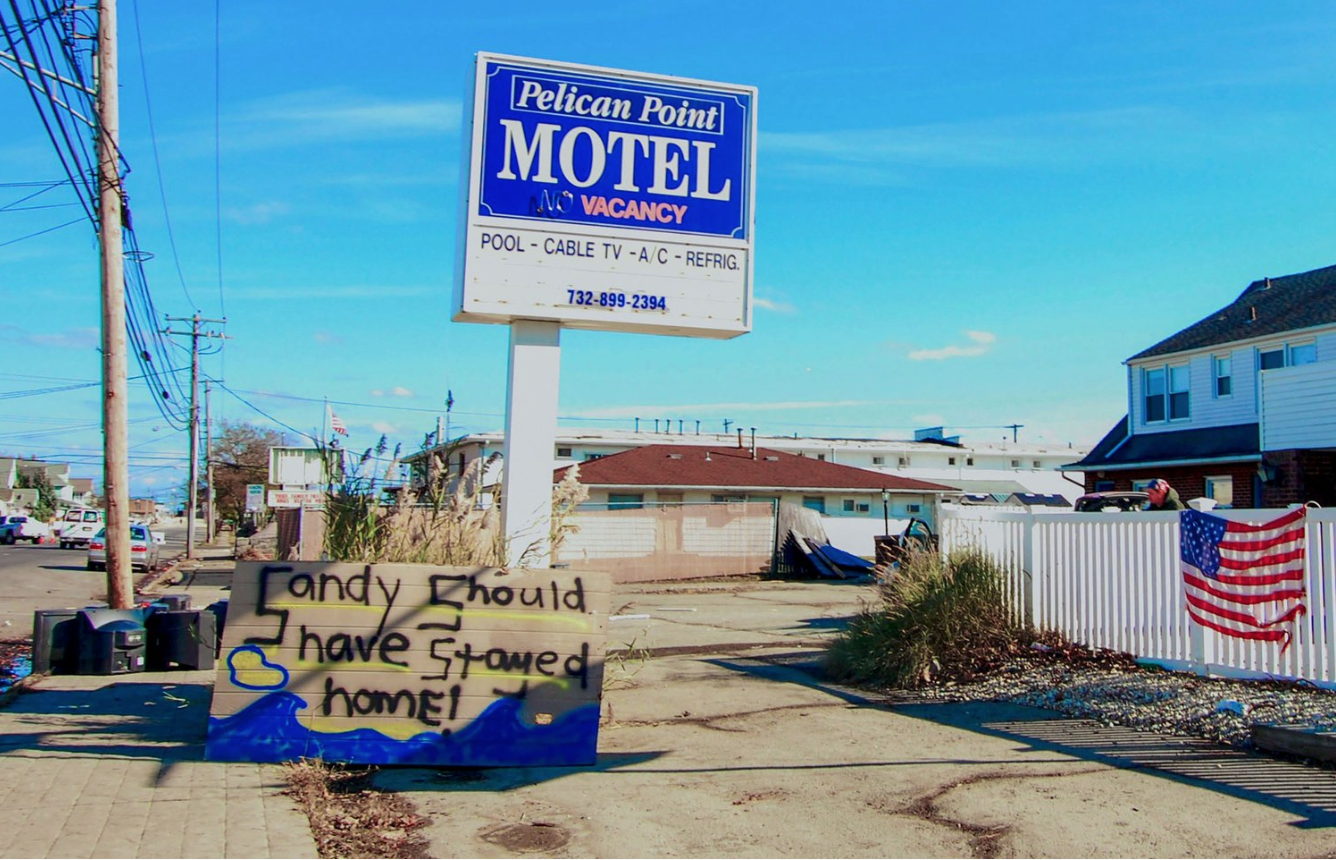10 Years After The Storm: Locals Talk About Hurricane Sandy / October 29, 2022
By Daniella Heminghaus
On October 28, 2012, the day before Superstorm Sandy made landfall in the area, crews in Point Pleasant Beach were putting sandbags along the boardwalk storefronts and making oversized sand dunes along the beach in hopes both would hold back potential flooding. Later that night as they worked to finish up the dune walls, large waves could be seen crashing in the distance. By morning much of the landscape along the New Jersey Shore and parts of New York had drastically changed. Homes destroyed, structures on fire, downed trees and debris in towns and cities across the tri-state area. Over 100 people would lose their lives in New Jersey and New York alone.

Through all the struggle of first cleaning the debris and pumping out any water left in people’s homes, then tearing apart and rebuilding, many neighbors took care of one another. Allie Wilson, who lived in Howell at the time of the storm, remembered how her block came together. “Thankfully the neighborhood that I grew up in was very tight knit. They don’t know what mutual aid is but they definitely do it. People would come and help cut down different things. If one person had a generator, I remember we had a fireplace and it was so cold, and all of my neighbors came over. They brought whatever they had in their fridge that was about to expire and we had meals, we were playing, all the kids were together.”
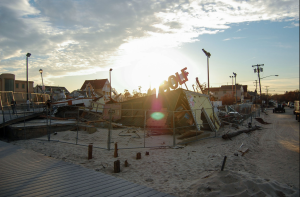
While communities came together to clear the initial storm damage, the snowstorm that followed only added to people’s stress. Wilson mentioned how this impacted her and her neighbors inland. “The initial shock of the hurricane or superstorm, whatever you’d call it at that point, was so bad but the thing that really killed people inland was the foot of snow that came not even a week after. Like I remember sitting at the table with my parents, we lost the power again, and we heard giant branches breaking in the distance and it sounded like gunshots. And we couldn’t tell if it was like transformers exploding, trees falling, just the sounds from that, you couldn’t differentiate them…Any infrastructure that was barely holding on with Sandy immediately got torn apart once a foot of snow fell in October.”
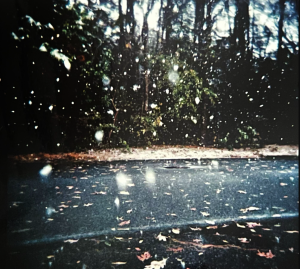
Echoing this is Jonathan Marinari, who lived in Brick at the time of the storm. “At the time I was living on the edge of Baywood and Shore Acres in Brick. An area that you still can see the aftermath. A lot of homes were simply walked away from.” Between the initial storm and the snow that followed, he was without power for close to 19 days and, he said, “the snowfall we had after Sandy actually caused the most damage to my property.”
Marinari and his young family headed to his parents home further inland to wait out the storm but even there, the storm wreaked havoc. The tree damage was as extensive as the flooding caused by a local waterway. But the one thing he said he’d never forget was when an emergency SUV driving along Mantoloking Road in Brick at night and hearing just how bad the damage was a few blocks east of his home. \”The bridge is gone. There are homes in the bay and the bridge is gone\” he recalled.
The storm surge Sandy caused had created a channel between the Barnegat Bay and the Atlantic Ocean right at the end of the Mantoloking Bridge. This caused dozens of sinkholes and destroyed much of the underground drainage systems along with people’s homes.

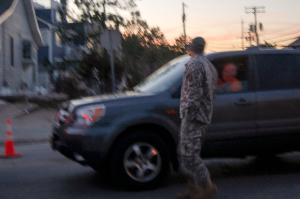
A few days later, he and his family went back to their home in Brick and the police and National Guardsmen presence left them feeling unsettled. Their home was just one block away from being severely damaged by floodwater. “It was a serious time. Even as an adult I hadn\’t really felt that kind of instability in my surroundings. Our house was a block away from people in kayaks going back and forth to their belongings. We were really lucky. When I did sell years later it was an honest selling point to my home that people liked. Walking distance to water and it survived Sandy. There was a boat not far from my house with a banner that said \”We will fish again\”. And we did.”
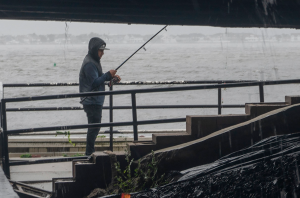
Allie Wilson and her immediate family lived in Howell at the time, but her grandparents and aunt lived in Bayville and Berkley, respectively. Her grandparents home sat on one of the lagoons in Bayville and had taken on three to four feet of water. “A lot of elderly people live in that area and it was so sad because my grandfather before hurricane Sandy was pretty independent. He spent most of his life either in the army, working in marinas, whatever. We always say hurricane Sandy took ten years off his life. He went from acting like a 60-year old whatever and then just the trauma of having to lose your house, completely rebuild, tear down everything, and rebuild at the age of 75. And it was so tough to see because they were like “oh we have to rebuild, we have to bring it back to what it is.” It was a whole family thing. I remember my aunts, my cousins, my sister, my parents and I, we were constantly spending a weekend where we would go down to Bayville and tear out drywall or do x, y, and z and it’s just astonishing seeing a storm take so much out…” Wilson’s grandparents got around $10 thousand from FEMA to raise their home but, at the time, chose to make it habitable again instead. At the time of this interview, Wilson’s grandmother said that she “wished [she] did raise the house.”
According to the New Jersey Department of Environmental Protection (DEP) and FEMA, if a person’s home is located in a flood zone and was declared “substantially damaged” by their local floodplain administrator or is new construction, a person has “no legal obligation to elevate if their home was not declared substantially damaged or is not in a flood zone.” The DEP stated that property owners must use the best available state or FEMA flood elevation data when contemplating raising their property. In a June 2013 fact sheet, the DEP stated that the New Jersey Flood Hazard Area Control Act rules, which were in effect since 2007, “require the lowest floor of each building in flood hazard areas to be constructed at least one foot above this elevation.” It also stated that the flood insurance program maps for the shore were “outdated and did not always accurately show the potential for flooding.” Newer FEMA Advisory Base Flood Elevations were released in December 2012.
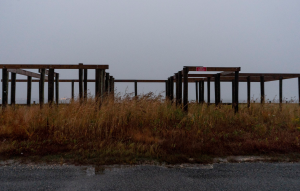
When people often think of the Jersey Shore, they imagine the boardwalks, beaches, and even the massive houses backed up onto the sand. But, like Wilson’s grandparents, not all whose homes were damaged were able to bounce back easily or quickly. Many fought with FEMA and the government for aid money. Some are still fighting the state over “clawbacks”, when state and/or municipal governments attempt to recover wrongfully distributed money. In an article by New Jersey Monitor, Assemblyman Robert Karabinchak (D-Middlesex), Chair of the Assembly Special Committee on Infrastructure & Natural Resources, said during a legislative hearing earlier this month that “many unscrupulous people took advantage” of the state’s multi-billion dollar aid payouts to help residents recover after Sandy. He added how more “oversight is needed” to ensure residents and business owners who need the aid would get it and not those trying to take advantage during disasters. Currently, the federal government is trying to get back $73 million in relief funds. They say these funds were incorrectly paid to 1,813 households in the state.

One retiree, Marita Vinci, is just now starting to move back into her Brigatine home which was damaged by Sandy 10 years ago. “I’m just starting to move back in and I just got a letter for a clawback 10 years later and half the time my paperwork’s missing.” She said that this is common as those whose homes were destroyed have their paperwork passed around from one person to the next be it in government or at the insurance companies. “A lot of times as it passes to somebody else as they’re trying to condense, somebody is let go and then somebody else takes over and they can’t find your papers and there you are again. So I just got this letter…it’s ten years of paper work. “ Vinci also had to deal with contractor fraud and the death of her husband while trying to fight to get back into her home. This is where the New Jersey Organizing Project come in. The group advocates for Sandy families to get back into their homes as well as pushing for disaster recovery programs that would put families first.
The Reforming Disaster Recovery Act , a bill that is in front of congress right now, would make a federal aid program permanent.
On this Wilson added, “that’s kind of the discussion too when it came to FEMA encouraging everyone to lift their houses. It was like some stupid measurement, it was like a foot and a half. We couldn’t do that. My grandparents they’re retirees. It’s so funny, because you could tell someone\’s socioeconomic status based on whether or not they lifted their house during Sandy [recovery].” Wilson added how her grandparents house isn’t big, it’s a modest ranch now among the many lifted and built up houses constructed after the storm.

According to the latest census between the years 2010 and 2020, people 65 and older made up for 22.4% of Ocean County’s population. The same age group accounted for 18.7% of the population in Monmouth County. Ocean County also happens to have the largest senior population in the state.
Sadly, many seniors and people living in assisted living facilities and nursing homes in New York City were stuck during the storm. In Brooklyn and Queens, New York, at least 29 facilities were “severely flooded,” according to a New York Times article from December 2012. There were buildings without generators and those with them had them fail, which led to the residents and staff to be without electricity, heat, food, and water. From there it took about three days for rescue crews to get over 4,000 nursing home residents and 1,500 assisted living residents. Many of whom were carried down stairwells, slippery from the storm. From there these people waited in ambulances and buses for hours before being taken to cramped shelters or nursing homes upstate. Many did not have charts or medications and their families often struggled to find where their loved ones had been placed. This was all after a decision had been made by city Mayor Michael Bloomberg and Governor Andrew Cuomo not to evacuate the nursing homes and assisted living facilities in more vulnerable areas before Sandy hit.

During Sandy, Devin Walby was working as a dining director at a senior living facility in Marlboro. Between the power outages and the debris blocking the roads, he found himself temporarily living among the residents for three weeks. The building had a generator but the generator only lit the residents rooms, his office, and the electric stove top. “We had a generator, obviously. The generator only lit residents\’ rooms and my electric stove top. So there are no lights in the dining room and no lights in the kitchen. Sandy was so severe that people could not commute to work because of fallen down trees and stuff. So I had to stay there for, both Irene and Sandy…” He slept in vacant rooms and the dining room because he was the person who had to take on any kitchen role needed when a staff member could not make it to work. “I took on these roles as well as my own. I remember I had a flashlight taped to my chef\’s hat and I was making meatloaf in the pitch black. And this went on for three weeks.” Between the power failure and jammed phone lines, Walby could not get a hold of the facility’s food vendors so he and the sole kitchen staffer who could safely get to work would recreate menus for their residents and when the food in the kitchen ran out, they headed out to the nearest grocery store. “We ran out of food at a point where I was taking money out of my salary, and luckily I had a decent salary, where I was running to grocery stores, because you couldn’t drive anywhere because the roads were closed down.”
By the third week, he left to go check on his mother who lived in Red Bank. On his walk there he saw countless trees downed and debris all over the roads from Marlboro to Red Bank. ‘I’m walking through this back way in Lincroft there’s just trees, trees, trees and I get to my mom’s house in Red Bank and there’s a tree slammed between her house and her neighbor’s house and I’m like ‘oh shit!’ I’m banging on the door screaming.” His mom was reading and his brothers were playing board games by candlelight. “I was just glad she was okay. Because again you’d look at your phone and you’d see things you’d never seen before. Just like dots, you’d go to make calls and it was just [giving the disengaged tone].”
Back at the senior living facility he worked at, the maintenance director had finally gotten a hold of contractors who were willing to bring and set up multiple generators. Downside was that these contractors were coming up from Virginia and had more than a handful of other contracts in the area to fulfill. The aftermath of the storm had taken its toll on Walby and his co-workers. “It was a […] nightmare. Everyday you’re doing 14-hour days, there’s no lights, because there’s no windows in kitchens because of bugs, you get a little light from my office because I propped my office open just enough to see that you’re not bumping into things. We had to move to all paper, which we didn\’t have supplies for because it was the maintenance person’s responsibility to order the back stock of paper. So we moved to paper because our dishwasher [wasn\’t] broken but to clean for 184 people including pots and pans. People don\’t think about how much dish that is…and none of this is accounted for. So that’s another three hours of work and you can’t tell if it’s clean because you can’t see. So the long and short of it was, everything that could have went wrong, went wrong.”
This was the major sticking point for Walby. The facility he worked out had brought in so much money each year and in one storm, it showed where that money was not being used. “Like the amount of money they brought in on a monthly basis versus how unprepared they were was jarring. And it starts to make you wonder, like ‘what am I doing, where is this money going, why is my budget so small?” But when talking about the three weeks he spent sleeping there, constantly improvising menus with a dwindling and limited food supply, and cooking with a flashlight taped to himself he said, ”I’ll never regret it. I did it for the residents.” Adding, “it was scary, I didn’t know when I was going home. But we got through it.”
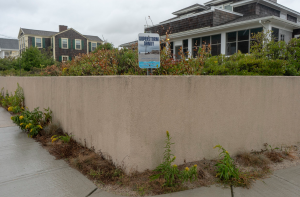
[This is the first article in a series relating to infrastructure and storm damage in New Jersey].
——————————————————————————
Sources:
opens in a new windowhttps://infrastructurereportcard.org/state-item/new-jersey/
opens in a new windowhttps://www.reuters.com/article/storm-sandy-jerseyshore-idAFL1E8M203Z20121102
opens in a new windowhttps://www.cdc.gov/mmwr/preview/mmwrhtml/mm6220a1.htm
opens in a new windowhttps://khn.org/morning-breakout/hurricane-sandy-nursing-home/
opens in a new windowhttps://www.nytimes.com/2012/11/18/nyregion/hurricane-sandys-deadly-toll.html
opens in a new windowhttps://newjerseyop.org/about-njop/
opens in a new windowhttps://www.census.gov/quickfacts/oceancountynewjersey
opens in a new windowhttps://www.census.gov/quickfacts/monmouthcountynewjersey
https://www.state.nj.us/transportation/commuter/roads/rt35reconstruction/impacts.shtm
Our press from the tenth anniversary event, as well as from NJOP members’ continued work to fight for a fair Sandy recovery, reached an audience of nearly 65,000,000. Check out the coverage we’ve been receiving down below.
- “ opens in a new windowUS storm survivors: We need money faster, less red tape” (Associated Press)
- This story was picked up by sixty outlets across the country, including the Washington Post, ABC News, The Press of Atlantic City, and The Independent.
- \”Sandy survivors say U.S. disaster recovery system is \’broken.\’ Here\’s how they\’d fix it\” (APP)
- “Storm survivors urge reforms to disaster-relief efforts” (NJ Spotlight)
- \”One of the lucky ones: Rebuilding a life after Sandy\” (Rising Together NJ)
- “Thousands of NJ families still not home 10 years after Superstorm Sandy” (News12)
- “For dozens of NJ families, returning home after Superstorm Sandy was a process years in the making” (News12)
- “A decade after Hurricane Sandy, fight to reform disaster relief continues” (New Jersey Monitor)
- “Thousands of Sandy victims in NJ are still paying for the superstorm 10 years later” (AccuWeather)
- \”NJ residents still fighting to get home, 10 years after Sandy\” (NJ 101.5)
- \”Ten years on, Sandy survivors slam storm recovery process\” (NJ Spotlight)
- \”Storm relief, climate progress still elusive decade after Hurricane Sandy, lawmakers told\” (New Jersey Monitor)
- \”Some Superstorm Sandy Victims Say They\’re Being Told to Pay Back Grant Money\” (NBC10 News Philly)
- \”Superstorm Sandy survivor remembers storm 9 years later\” (Fox Weather)
- \”SANDY 10 YEARS LATER: The nightmare of Sandy fraud\” (WCBS News Radio)
- \”Sandy: 10 Years Later – Sandy\’s Impact on New Jersey\” (News12 NJ)
- \”Superstorm Sandy families reflect on the Jersey Shore one decade later\” (AccuWeather)
- \”10 years after Superstorm Sandy, N.J. lawmakers tout infrastructure investments to prevent future disasters\” (CBS NY)
- \”The long journey home: Some Sandy victims never fully recovered from the storm\” (NJ.com / Star Ledger)
- \”Some Still Rebuilding A Decade After Sandy\” (Jersey Shore Online)
- \”Superstorm Sandy\’s sustained emotional toll on survivors\” (NJ Spotlight)
- \”Sandy crushed the Jersey Shore. Here\’s how the rescue plan washed away the middle class\” (APP)
- \”Superstorm Sandy Town Hall\” (NJ 101.5)
- “10 years since Superstorm Sandy: Overhaul broken disaster recovery system” (The Hill, op-ed)
- “How Hurricane Sandy transformed the Jersey Shore into \’a playground for the rich\’” (Business Insider)

